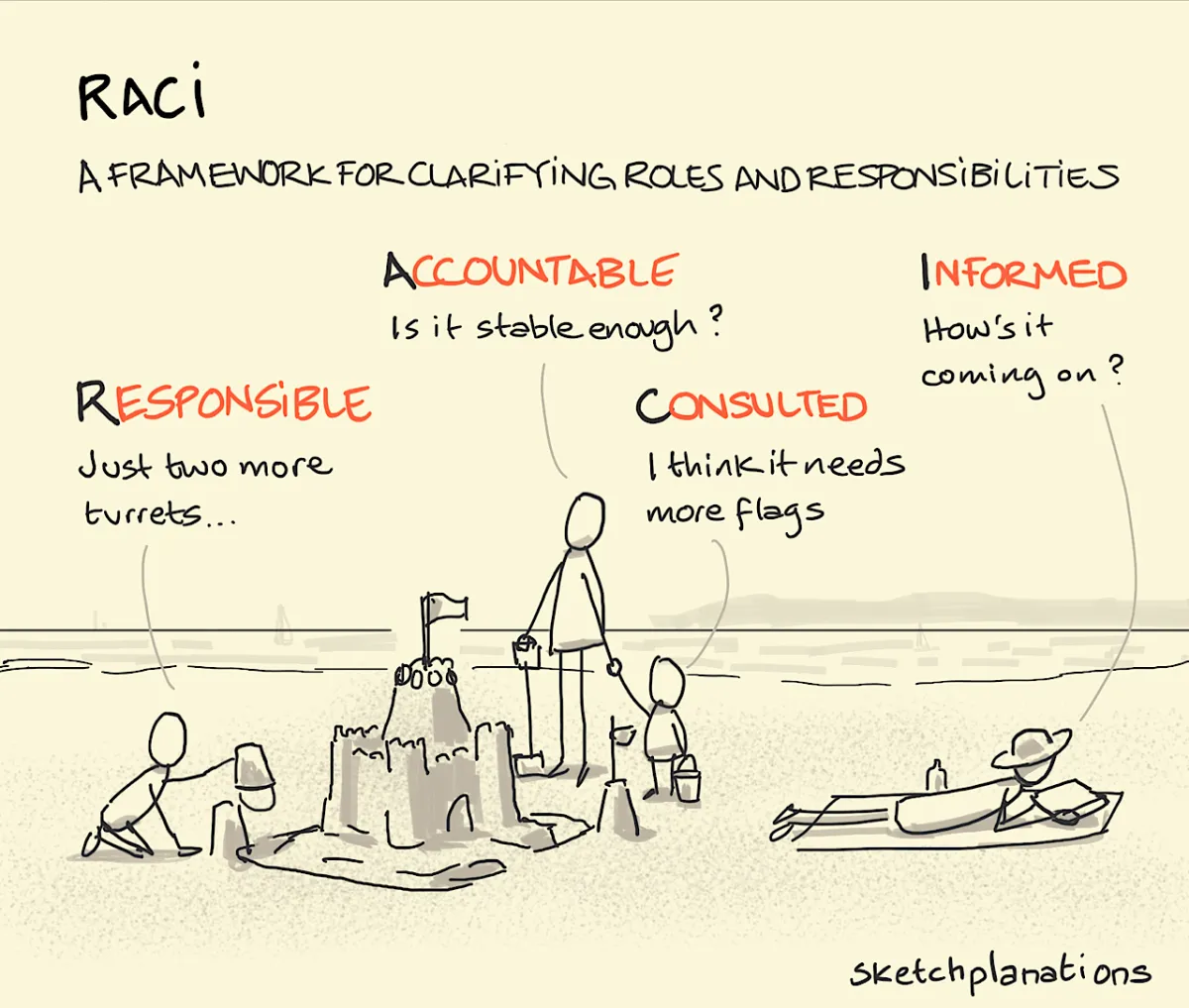
RACI Matrix Explained Through a Sandcastle | Business English for IT Professionals
What Sandcastles Teach Us About Project Management (and Business English!)
Why a Sandcastle?
It’s easy to start building one, right?
You grab the sand, fill the bucket, turn it upside down, and ta-dah—instant castle!
But if you’ve ever built one with friends (or kids), you know what happens next:
someone collects shells, another smooths the towers, a third adds water… and five minutes later, no one’s sure who’s doing what.
The result?
A half-built structure that collapses with the first wave. 🌊
The same thing happens in many IT or business projects.
Without clear roles and responsibilities, even talented teams end up duplicating tasks, missing steps, or—worse—blaming each other when things go wrong.
That’s where the RACI Matrix comes in.
What Is the RACI Matrix (and Why Should You Care)?
The RACI Matrix is a simple but powerful project management tool that defines who does what in a team.
RACI stands for:
Responsible → The person who does the work.
Accountable → The person who owns the result and ensures success.
Consulted → The people whose input and expertise are needed.
Informed → Those who need to be kept up to date.
In other words, RACI is the “map” that keeps your project from sinking into chaos.
💡 Keyword focus: project management clarity, team collaboration, communication in IT, business English vocabulary.
How the RACI Matrix Builds Stronger Teams
When applied well, RACI doesn’t just improve workflow—it improves communication, efficiency, and team morale.
Here’s how:
1️⃣ Clarity of Roles
Everyone knows what’s expected. No overlapping responsibilities, no “I thought you were doing it.”
Example (Business English phrase):
“Let’s clarify who’s responsible for final delivery and who’s accountable for client communication.”
2️⃣ Accountability and Trust
When accountability is visible, teams communicate more transparently.
It also gives you the vocabulary to express ownership clearly.
Useful phrases for meetings:
“I’ll take ownership of that task.”
“You’ll be the point of contact for this deliverable.”
“Let’s align on who will sign off the final version.”
💬 These expressions signal professionalism and confidence—core goals in Business English.
3️⃣ Better Collaboration Across Functions
In cross-departmental projects (IT + Marketing + Operations), confusion is common.
The RACI framework acts as a translation layer—just like good English communication.
Example (IT context):
Responsible: Developer writing API documentation
Accountable: Project Manager ensuring delivery
Consulted: QA team for testing
Informed: Product Owner about the release date
This structure prevents miscommunication—a key pain point for many non-native speakers managing global teams.
4️⃣ Transparency and Efficiency
When everyone knows who’s in charge, discussions become shorter, and decisions faster.
💡 Pro tip: Try combining your RACI chart with meeting agendas. Start each item by asking,
“Who’s R? Who’s A? Who needs to be informed?”
This keeps business meetings in English focused and productive—a skill every professional can practice.
The RACI Matrix as a Business English Exercise
Let’s take this concept one step further. You can use RACI not only for management—but also for language practice.
Here’s how:
🧩 Activity 1: Create a RACI for Your Own Role
Write down a recent project you worked on. Then describe it in English using RACI vocabulary.
Who was responsible for each task?
Who was accountable for final approval?
Who did you consult with?
Who did you inform regularly?
✅ Business English Vocabulary Focus:
deliverables, ownership, stakeholders, approval process, escalation, cross-functional, alignment.
🎯 Activity 2: “Clarify & Confirm” Role-Play
Pair up with a colleague or a study buddy. Practice short dialogues like these:
Scenario 1 – Role Clarification:
A: “Can we confirm who’s accountable for the timeline?”
B: “You’re responsible for the dashboard, and I’m accountable for the overall delivery.”
Scenario 2 – Feedback Round:
A: “Who should be consulted before sending this report?”
B: “Let’s include QA for data validation before sharing with management.”
This builds confidence in functional communication—especially useful for meetings in international teams.
💡 Activity 3: RACI Reflection for Continuous Improvement
At the end of each sprint or project, ask yourself (in English):
“What went well in our collaboration?”
“Where did communication break down?”
“Which roles were unclear?”
By turning RACI reflection into a language activity, you improve not just your teamwork, but your professional fluency too.
Common Mistakes (and How to Avoid Them)
1️⃣ Too Many Rs (Responsible):
If multiple people “own” a task, no one really does.
→ “Let’s assign one main responsible person for this action point.”
2️⃣ No A (Accountable):
When no one is accountable, deadlines disappear.
→ “Who has final sign-off authority here?”
3️⃣ Consulted vs. Informed Confusion:
You don’t need to ask everyone for input. Some people just need updates.
→ “We’ll inform the wider team once we finalize the prototype.”
Why RACI Matters for Global IT Professionals
When you work across countries, RACI becomes even more essential.
Cultural differences can blur expectations—some teams assume initiative, others wait for instructions.
A clear RACI bridges these gaps, creating predictable structure and shared language.
In English communication, it also helps you practice assertiveness and clarity—two areas non-native professionals often struggle with.
“Good English” at work is not about fancy words.
It’s about clarity, ownership, and consistency—exactly what RACI teaches.
Final Takeaway
Whether you’re managing a complex IT rollout or building a sandcastle on the beach, success depends on structure, clarity, and teamwork.
A well-defined RACI Matrix gives your team the same stability that wet sand gives your castle—it keeps things standing tall.
So, next time you kick off a new project:
📋 Define your RACI.
🗣 Communicate it clearly.
💼 Practice it as part of your Business English.
And remember: in both projects and communication, the key to success isn’t just knowing the rules—it’s making sure everyone understands their role in the story.
Image credits: https://sketchplanations.com/raci
